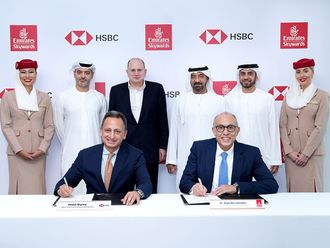Dubai: According to the newish Managing Director of the IMF, Christine Lagarde, we, (being the global economy), "run the risk of what some commentators are already calling the lost decade".
From an ageing perspective, for many, a good thing. Unfortunately, Lagarde doesn't do jokes and more completely refers to a threat to a generation of wealth building: "Our sense is that if we do not act boldly and if we do not act together, the economy around the world runs the risk of a downward spiral of uncertainty, financial instability and potential collapse of global demand."
More evidence than of last week's warning that investors need to prepare for a period of low growth, batten down on aggressive investment returns and aim to protect capital before there is nothing to protect.
But you know this, right? After all, you will have read the headlines: The Greeks survive for another day, Berlusconi doesn't, and markets go up and down in between. What the newspapers do not provide is advice. This space then, provides what other spaces do not — a top tip: get yourself a benchmark.
Gold dust
Experienced investors and financial advisers will know this already. But for those not-in-the-loop the following is gold dust: a benchmark is a target, and if you don't have a target what are you aiming at?
Important because investment is a performance business. It matters not how competitive you are — you simply must know your benchmark otherwise, to extend Lagarde's warning: you will be stressed.
Benchmarks might be less of an issue in rising markets when everyone is a genius and everyone is making money. But, to play further with Lagarde's words: these don't look like continuously rising markets.
So lets focus on benchmarking. Imagine a visit to the gym, you are on the treadmill. In front of you are three human specimens, hamster-fashion, on their treadmills. Specimen A is walking at a leisurely pace, Specimen B is trotting and breathing easily; with Specimen C sprinting and gasping for air. Like the treadmill, setting the pace for your investment is a matter of individual taste.
However, some practicalities need to be added to the pace of our portfolio-treadmill. Firstly, if we don't have much capital to play with, then sprinting all the way by investing into volatile emerging market equities may well exhaust our capital too early.
The standard
Similarly, if we need to improve our purchasing power, then our pace needs to be faster than the rate of inflation. Investing in bank deposits with returns lower than the rate of inflation means we are not exercising our portfolio treadmill hard enough.
Once we have a treadmill "standard" we can start to look at the things that affect that standard. Two kilometres in 30 minutes, can this be improved? Two per cent over the rate of inflation, can this be improved? Now we are getting into sophisticated planning mode.
Do I train in the morning? Do I need to sleep for eight hours or will six hours do? What should I eat and when? All these factors will influence the 2km-in-30-minutes standard.
Right pace
The financial adviser is our personal trainer. Should we increase the weight we are carrying in bonds? How much would a large holding in government debt slow down the overall growth prospects? Citywire ran a heading this week: "Could junk bonds be the new safe haven?", how true or ludicrous is that?
Most importantly, is the pace of our portfolio right for these times? How much notice do we take of the likes of Lagarde, and if her comments are to be tweaked into our portfolio in what way do we tweak?
The writer is Chairman of Mondial Financial Partners.












